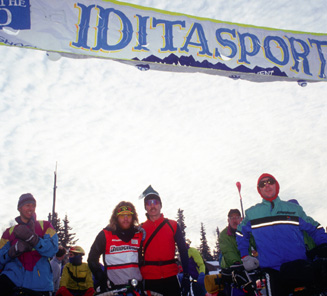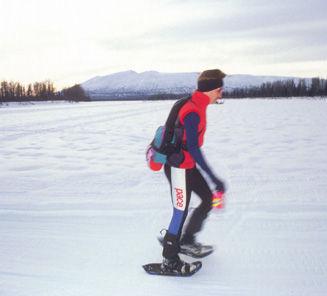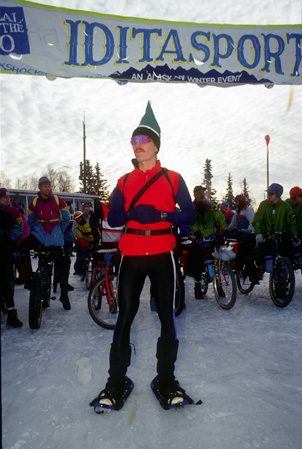Alaska’s the kind of place where, unlike the other 49 American states, a car is about the least likely way of getting around. Much of the state can only be accessed by light aircraft. More than half the year, most people get around by snow-machine (called “snow mobiles” in the rest of the world). But the true Alaskans, and the true athletes, prefer a dog team, skis, snowshoes, or even bicycles for getting around America’s largest state. That, of course, gives rise to all manner of competitive events. Following the creation of the 1150-mile long Iditarod Trail Sled Dog Race in 1973, ski and showshoe races began taking place on a 100-mile stretch of this trans-Alaska trail by the early 80s. In 1987 the 200-mile Iditabike Mountain Bike Race was founded by Dan Bull, then in 1991 Bull rolled all these “undog” events into a human-powered extravaganza called Iditasport. That race was held until 2001 and I competed seven times. I raced the 200-mile mountain bike race in 1988, 1989, and 1991, then in 1993 I opted for the 100-mile snowshoe division. I wanted to "traverse land more home to moose than man" with a simpler approach than in my previous three races there on a bike. Plus after having pushed and shoved my mountain bike anywhere from 15 to 60 miles of the 200-mile bike race in previous years, due to snow too soft or rutted to support a bicycle tire, I was looking forward to using equipment more logical and appropriate for trekking through Alaska in wintertime. Having become a major enthusiast and proponent of snowshoeing (my goal then was to become the Jim Fixx of snowshoeing, minus the heart attack, of course), I also wanted to give it a go in the sport's toughest and most revered event. Also, I truly feel a part of something historic when I’m on snowshoes since they date back 6,000 years in the archaeological record. One hundred miles on snowshoes promised to put me in touch with something ancient, even primordial. The shoes didn't let me down... 
Immediately prior to race start, all entrants had to show their required survival gear and demonstrate that their stoves actually could melt snow to produce water. I flabbergasted the organizers and the other entrants by displaying a mere eight pounds of gear. In the classic tradition of the race, the other snowshoe racers pulled sleds with their required (and truly functional) winter survival gear, but I opted for a butt pack stuffed with the lightest, smallest equipment possible and a Camelbak with my fuel. So while the others pulled 20 to 40 pounds of gear, I lugged eight pounds. My gear met the rules in a technical sense, but probably didn't match the intent of the rules - to insure survival in the case of blizzard, getting lost, or injury. As a three-time veteran, I knew what I was getting into and I assumed I was competent to take on the risk. Then again, I live in California near the beach, so what do I really know? (See sidebar for gear and clothing lists.) Under a banner stating “Cowards Won’t Show and Weak Will Die,” the race got underway at 10:20am on February 20, 1993. The sky was clear and the temperature was six degrees F. The trail was much harder than other years as it had melted and then refrozen in the previous days. Setting off into the Alaskan wilderness were 56 athletes: 27 mountain bikers, 13 cross-country skiers, 10 snowshoers, 4 runners, and 2 snow-triathletes (bike, run, ski) representing the U.S., Canada, Holland, Germany, Spain, Switzerland, France, and Australia. The race began by crossing the ice of appropriately named Big Lake. I joined seven-time winner Shawn Lyons and rookie entrant Allen Benjamin, an Athabascan Native American from Northern Yukon Territory, in setting the pace. Leaving the frozen lake behind after five miles, we set off into the wilderness. Two quick stops to tend to my feet put Lyons and Benjamin ahead. The 40 miles to the first of only three checkpoints on the race course was rolling terrain with lots of snow-machine-induced whoopdedoos or moguls. Combined with the pavement-hard trail, this made the going tough on our feet and ankles.
I caught Lyons at the first checkpoint, Big Susitna, after five hours and 38 minutes and 40 miles of running. I was five minutes ahead of his record pace upon arrival and left the checkpoint as soon as I filled a new bladder for my CamelBak. Each bladder contained 1200 calories of Endura Optimizer and I planned to do the whole race on just three bladders. (This was the one place on the course where we could send a “drop bag” via ski plane, so I had sent two bladders with my Optimizer powder already in them, plus my headlight and batteries.) By blitzing through the checkpoint, I put myself 54 minutes ahead of Lyons' course record pace. But my run in second place was short-lived as I soon had to stop to install Moleskin on my heels. Lyons hunkered past while I sat barefoot in the snow tending to my feet. Now we were on the Iditarod proper and the terrain became hillier and forested. My Atlas snowshoes provided fantastic traction on the up and downhill parts of the trail, but were otherwise unnecessary due to the firmness of the trail. However, since I had declared snowshoes as my "weapon" for the race, I couldn't remove them and run in just my running shoes instead. But that was OK, for I was here for the ultimate snowshoe experience. A 40-minute detour around open water at a creek crossing cut into Lyons' and my time. Benjamin, the native winter person that he is, just plowed through the icy water to double the 40-minute lead that he already had over us. The guy's tough; near the finish line I would see his blood on the trail, having seeped through his caribou skin mukluk moccasin-boots from the sawing action on his feet cause by the bindings of his traditional snowshoes. Unreal. As I pressed on into the night, I alternated running, jogging, and walking on the flats, but ran all the downhills. Between the snow and my sweat, my feet were constantly wet in the running shoes to which my snowshoes were strapped, so twice I stopped to wring the water out of my Thor-Lo running socks. (I was really getting tired of the ice water pooling around my toes on the downhills!) Eventually I caught a mountain biker named Scott Jahns and he gave me his spare socks. Wool and full length, no less! With half the race behind me and still ahead of the record pace, I began to feel the miles of pounding. Having never run further than a marathon before (and that in the Canadian Ironman 18 months before - my only "long" training run for this race was a 12 miler on pavement), I was venturing into terra incognita. I started to lose it, big time. The next ten miles into Rabbit Lake, the checkpoint at mile 70, were the most painful of my life. My feet and ankles began to swell and each step evoked a moan, a groan, or a whimper. Words don't describe how much pain I was undergoing. In cycling there's always the opportunity to coast, but in foot races one has to earn every inch of ground that one covers. This was pain of the highest degree. Complicating things even more, I soon ran out of Optimizer and began to really notice the six-degree temp as I became more and more dehydrated. Not running or drinking anymore meant I wasn't generating or circulating too much heat, so I started to get cold. I stumbled along in the darkness, begging, even screaming out loud to see the lights marking the Rabbit Lake checkpoint. With each breath, I could see water exhaling from my body, thickening my blood and making me thirsty. Starting in my hands and feet, numbness was creeping in towards my torso. But life was about to get more interesting than even that. I had been noticing something strange and, at first, incomprehensible, as I hiked through the darkness: Tiny lights kept appearing off to my right in my peripheral vision. After becoming aware of this and “seeing” it several times, the mysterious lights revealed their source when I stopped to make some yellow snow. I had turned 90 degrees to my right on the trail and my headlight was shining off into the trees. There, I saw the unmistakable reflection of a dozen pairs of wolf eyes glowing in the glare of my headlight. As the steam rose up from the snow beneath me, I suddenly realized why I’d been seeing “lights” off to my right over the past few miles: the wolves were pacing alongside me in the woods! Now they were stopped, watching me, presumably giving me a proper look-over. 
Needless to say, that freaked me out. Relieved of seemingly the last bit of fluid in my body, I headed down the trail, more intent than ever to get to the Rabbit Lake checkpoint. Along the way, I strained to see in my peripheral vision. (Of course, I didn’t want to actually look directly to my right.) For another half hour or so, the wolves shadowed me. Then they were gone. About an hour later, I came over a rise and entered a battlefield: There were prints and blood ALL over and near the trail where the wolves had attacked a moose. It was like coming upon a murder scene, just after the attack took place: I could see just where the wolves had pulled the moose down and it had crashed into the snow. Then it had somehow thrown off the wolves and gotten back up, staggering off the trail into the soft snow to the right. There, another big pit in the snow indicated where it had fallen down again; there was more blood where the wolves had sunk in their teeth once more. But the battle trail headed off into the trees and I couldn’t tell how it had ended. All was quiet as I stood amidst the bloody snow and carnage. Time to get moving Finally I arrived at Rabbit Lake, still in third place, but with my body totally shut down and barely moving, I was quite sure that my race was over. After warming up in the checkpoint tent for 90 minutes, I decided to sleep. (Fortunately another tent was available for me to sleep in, for my "survival gear" wouldn't have done me any good.) Standing up, I found that I couldn’t lift my legs a millimeter; it felt like my feet were super-glued to the tent floor, so the two race volunteers dragged me to the other tent to sleep. My legs were so blown that I had to use my hands to push them into position in the sleeping bag, like a paraplegic might do. After an eight-hour sleep, I woke up and stuck my head outside the tent. Assuming I wanted to quit, the race volunteers told me that I could be flown out within an hour. As I got up I found that I could kind of hobble again, almost walk. It wasn't easy, and was far from pain-free, but I was feeling giddy after my eight-hour nap, so I decided I had to push on. I figured that I'd loosen up after ten miles or so. The problem was, I was starving. I hadn’t planned on an extra ten hours on the trail for this break, plus the previous section had taken me far longer than planned, so I was in a major calorie deficit. I had to eat, but the race rules prevented the volunteers from giving me anything other than hot cocoa and Tang. That wasn’t going to cut it.
It was 7 degrees out and I had 30 miles to go, but I had just my one remaining bladder of Optimizer for fuel. That would get me down the trail, but I desperately needed some breakfast before I could head out. A light bulb going on in my head, I headed for the back of the checkpoint tent, where the trash was kept. Surely some of the other racers who had gone through this checkpoint during the night had left something to eat! And so they had: Breakfast that beautiful, crisp, cold Alaskan morning was my fellow competitors' throw-aways: three bites of a PB&J sandwich, half a brownie, about a dozen yogurt-covered raisins, and half an energy bar covered in pocket fuzz. Renewed by other people's unwanted calories, I was ready to hit the trail. Amazingly, only two snowshoers (Western States 100 winner Sally Edwards, the sole woman entrant, and Michael Nee) had passed me during my ten-hour layover; the others behind were hoofing it slowly or had bivvied out on the trail behind me for the night. I hit the trail hoping to hold onto fifth place. Knowing Lyons had covered the remaining 30 miles in six hours and eighteen minutes the year before, I hoped to make it in about eight hours. Heading down the trail, I thought only about the present moment: each breath, each step, each piece of trail covered, and never did I think of the finish line until I actually saw it. I stopped for nothing and nursed my CamelBak carefully so as not to run out of Optimizer. (Stretching 1,200 calories out over eight hours was really living on the edge, to say the least.) I trudged for hour after hour after hour, feeling like the Energizer bunny: I just kept going and going and going. It was truly amazing to walk as far as the horizon, look to the new horizon, walk to that horizon, and repeat that process over and over and over again. It was also a treat to see this part of the trail in daylight, for in previous years I'd always ridden or lugged my bike through in the dark. The Iditarod Trail and its environs are, quite simply, stunningly beautiful. Further distinguishing this experience from previous years was the fact that I was totally alone this time. This put a whole new and exhilarating twist on the race. Fully on my own, in the wilderness, doing something as simple as mindfully walking, was an almost surreal experience. Eventually I numbed out to the pain. Life was bliss. About eight hours after leaving Rabbit Lake, the finish in Skwentna came into view. I couldn't, and didn't want to, choke down my emotions. I was exhausted but exuberant as a few sobs of happiness burbled up my throat as I ran down to the finish line. I finished in 5th place in 32 hours even. Fourteen hours earlier, Benjamin had beaten Lyons in a sprint, completing the distance in a new record time of 18:01. It had been a heck of a race for all of us. |
|||||
 |
 |

